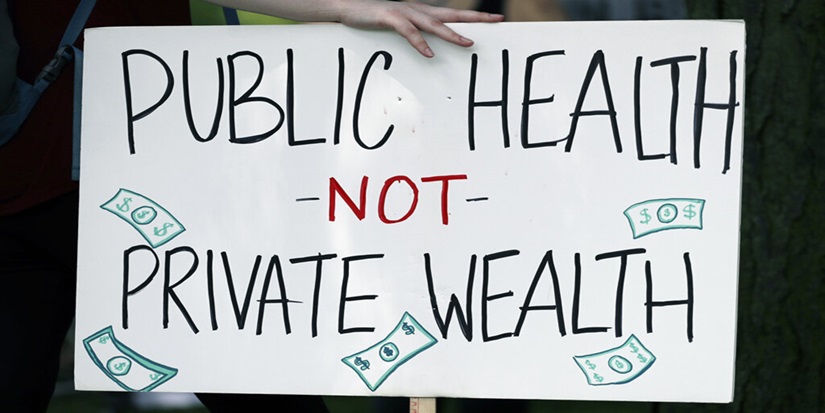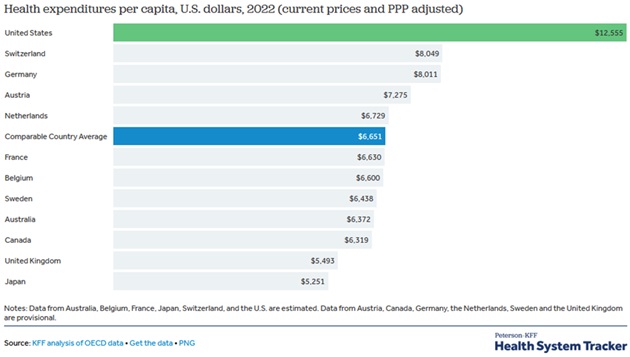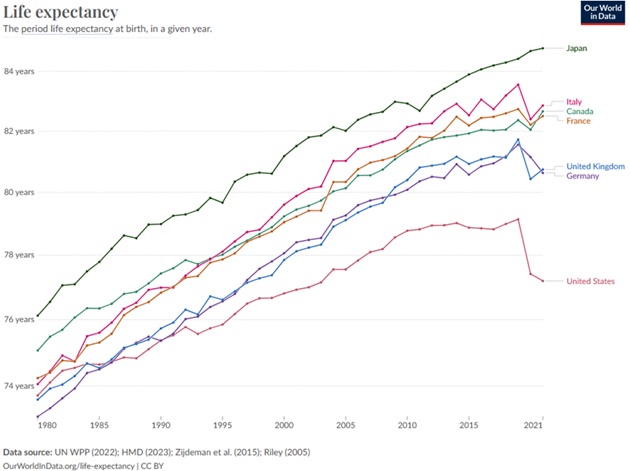
Health and Wealth
-
 Patrick Watson
Patrick Watson
- |
- August 20, 2024
- |
- Comments
It’s election time again in the US. We have a new issue this time. Republican VP candidate J.D. Vance talks about declining birth rates and what can be done to reverse them.
Whether or not you like Vance’s ideas, he touches on the global labor shortage. It’s not just a US problem. Around the world, people have been having fewer children for decades. Many countries don’t have enough working-age people even as their elderly populations grow.
The US has done better than most because we are generally more open to immigration, but that creates other issues. One thing is clear, though: The economy needs to keep its limited labor force healthy and productive. Further, it needs to do this at a reasonable cost.
If those are the goals, the US is performing not just badly but terribly. We have the developed world’s highest healthcare costs and worst health outcomes. It’s not even close.
Our economy will never reach its full potential until we fix this.

Source: Pixabay
Failing Health
Last month in Things Fall Apart, I described how segments of the economy are, well, falling apart. Not disastrously so, but in a kind of slow deterioration that’s causing noticeable problems.
The reader responses focused mostly on healthcare. Some examples...
“Wow—you are spot on with this article. My husband called for an executive physical at Cooper Clinic (in your backyard) and was told the earliest available spot is July 2025. We resorted to Cleveland Clinic and must wait almost 4 months. Medicine is broken. My physician clients want OUT. It isn't about the patient any longer. We are experiencing socialized medicine now despite no legislative action deeming this true.”
Like what you're reading?
Get this free newsletter in your inbox regularly on Tuesdays! Read our privacy policy here.
The Cooper Clinic part is interesting. In theory, these high-priced private providers, being less subject to cost pressures and managed care constraints, should work better. Maybe they are besieged with wealthy patients who can’t get in elsewhere. But the effect is the same; a long wait to get the services you need.
|
Another reader says…
“When it comes to the issues of healthcare, part of the problem is that we have never, in recent times, had a system focused on health. What we have is an Illness & Injury Repair System. Why? Because that is where the big money is. Massive revenues for big pharmaceutical, medical equipment and insurance companies; lucrative careers for senior medical professionals and bureaucrats; great photo ops for politicians opening yet one more very expensive facility. The front line staff, nurses, lab and radiology techs, etc., are treated as disposable fodder and are leaving the industry in droves.
“As with so many other parts of our socioeconomic system, they no longer serve us; we are there to serve them as anonymous data points known as consumers.”
This points to another quandary. Even as most people have to wait longer and pay more for inferior healthcare, some parts of the healthcare industry are getting more and more profitable. Meanwhile others are being squeezed out of business. That doesn’t really make sense. It says something is seriously wrong with the structure and incentives.
Speaking of which…
“I wonder what the ratio of administrative to caregiver personnel might be, in the average hospital today? And what the proportion of employed versus independent doctors might be compared to 50 years ago?”
I don't know the ratio, but there's certainly a vast apparatus devoted to insurance claims and billing. It’s not clear if this saves money or improves our health.
Here’s another one:
“Hi Patrick: My younger daughter is a pharmacist in a New England hospital, and she was home this weekend describing some of the—peculiar—decision-making that goes on in the hospital environment.
“I spent many years as a technical manager at the American Institute of CPAs (I'm a CPA licensed in Connecticut for 40+ years). I used to dread dealing with health care accounting, because the GAAP reporting is, IMO, bizarre. Generally, if the accounting is bizarre, that's because the system is bizarre.”
“Bizarre” definitely fits. Just look at your doctor’s or hospital bills and compare them to what you and your insurer actually pay. It makes no sense at all.
Worse, we Americans spend far more for healthcare than anyone else does. According to the Peterson-KFF Health System Tracker, per capita US healthcare expenditures were $12,555 in 2022. In an index of comparable countries, the average was only $6,651.

Source: Peterson-KFF Health System Tracker
Remarkably, we spend more per capita than even fast-aging Japan. It’s not even close. Their healthcare costs are less than half of ours. Yet by all kinds of measures, Japanese people live longer, healthier lives. Ditto for all the other countries on this list.
The US has the lowest life expectancy in the G7 and the gap is widening.

Source: Our World in Data
Like what you're reading?
Get this free newsletter in your inbox regularly on Tuesdays! Read our privacy policy here.
I don’t know all the reasons for this difference, but it’s a serious economic problem. This cost difference represents a massive misallocation of resources we could be using in better ways. The Affordable Care Act may have helped but certainly not enough.
We should talk about this more. But apparently, we’d rather just keep paying.
|
See you at the top,

Patrick Watson
@PatrickW
P.S. If you like my letters, you’ll love reading Over My Shoulder with serious economic analysis from my global network, at a surprisingly affordable price. Click here to learn more.

 Patrick Watson
Patrick Watson
